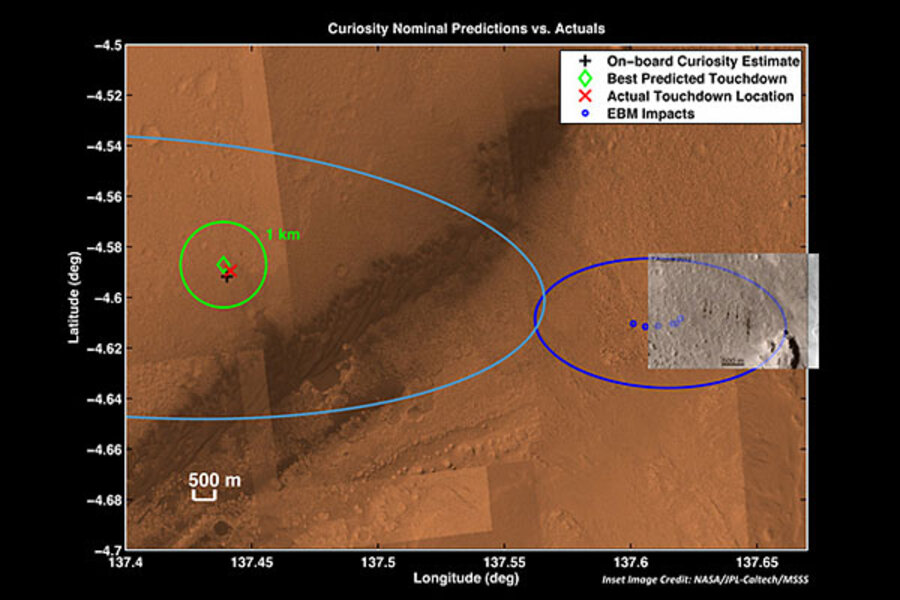NASA's $2.5 billion Mars rover just taking it easy for now
NASA's Mars rover Curiosity marks a full week on the Red Planet today (Aug. 13), and it's celebrating with a little rest and relaxation.
The 1-ton rover began beaming home photos and testing out its 10 science instruments almost immediately after its dramatic landing on Mars on the night of Aug. 5. But Curiosity is now in the middle of a four-day quiescent period, transitioning from landing software to programs optimized for surface operations.
The new software package "has a lot of great stuff that the science team wants, that the surface team wants, in order to enable this fantastic mission," Curiosity lead flight software engineer Ben Cichy, of NASA's Jet Propulsion Laboratory(JPL) in Pasadena, Calif., told reporters Friday (Aug. 10). "That's why we're willing to spend some time here doing the install."
A lot to be proud of
Though the $2.5 billion Curiosity has been on the Red Planet for just a few days, it already has a lot to be proud of. For starters, it exectued a daring and unprecedented landing pretty much flawlessly. [Amazing Mars Rover Curiosity Landing: Best Moments]
In the last phase of Curiosity's entry, descent and landing (EDL) sequence, a rocket-powered sky crane lowered the six-wheeled robot to the floor of Mars' Gale Crater on cables, then flew off and crash-landed intentionally about 2,000 feet (600 meters) away. Such a maneuver had never been tried before on another planet.
Curiosity also employed a guided-entry system, enabling the rover to touch down much more precisely than any Red Planet robot had before. Preliminary analyses show that the rover missed its mark — dead center of its 4-by-12-mile (7 by 19 kilometer) landing ellipse — by just 1.5 miles or so (2.4 km), researchers said.
"Obviously, we had a great day on Mars on Sunday," said EDL operations lead Allen Chen of JPL.
And the rover's equipment is working very well on the surface so far, researchers said. Mission scientists and engineers have yet to encounter a major issue with any of Curiosity's 17 cameras or 10 science instruments.
That high-tech gear has already been put to use. Curiosity has sent lots of images back to its handlers, including footage of its harrowing descent and a color panorama of its landing site. And the rover's Radiation Assessment Detector instrument took a 3 1/2-hour measurement Wednesday (Aug. 8), gathering data that could help NASA plan for future manned missions to the Red Planet.
What to expect
Curiosity's software switch should wrap up by Tuesday (Aug. 14). The rover should then be ready to roam, flex its 7-foot (2.1 meters) robotic arm and really put its instruments through their paces.
But the mission team will take things slowly, vetting the rover for a few months to ensure that it's in tip-top shape. Curiosity is the most complex and capable robotic explorer ever sent to another planet, NASA officials have said, so it's important to check it out thoroughly.
And there's no huge rush, researchers have stressed. Curiosity's prime mission is slated to last for nearly two Earth years, but the robot's plutonium power source could keep it roving for considerably longer than that if no key parts break down.
Curiosity's main goal is to determine if the Gale Crater area could ever have supported microbial life. It will investigate the rocks and soil of Gale and Mount Sharp — the mysterious 3-mile-high (5 km) mountain rising from the crater's center — to get at this question.
While it's still early days, all signs currently point to an interesting and rewarding mission, researchers say.
"With the spacecraft being as healthy as it is and the capability that it has, all our options are open for science," Curiosity chief scientist John Grotzinger, a geologist at Caltech in Pasadena, said Wednesday.
Visit SPACE.com for complete coverage of NASA's Mars rover Curiosity. Follow SPACE.com senior writer Mike Wall on Twitter @michaeldwall or SPACE.com @Spacedotcom. We're also on Facebook and Google+.
- Mars Rover Curiosity: Mars Science Lab Coverage
- Curiosity Camera Snaps Heat Shield Separation | Video
- 1st Photos of Mars by Curiosity Rover (Gallery)
Copyright 2012 SPACE.com, a TechMediaNetwork company. All rights reserved. This material may not be published, broadcast, rewritten or redistributed.





